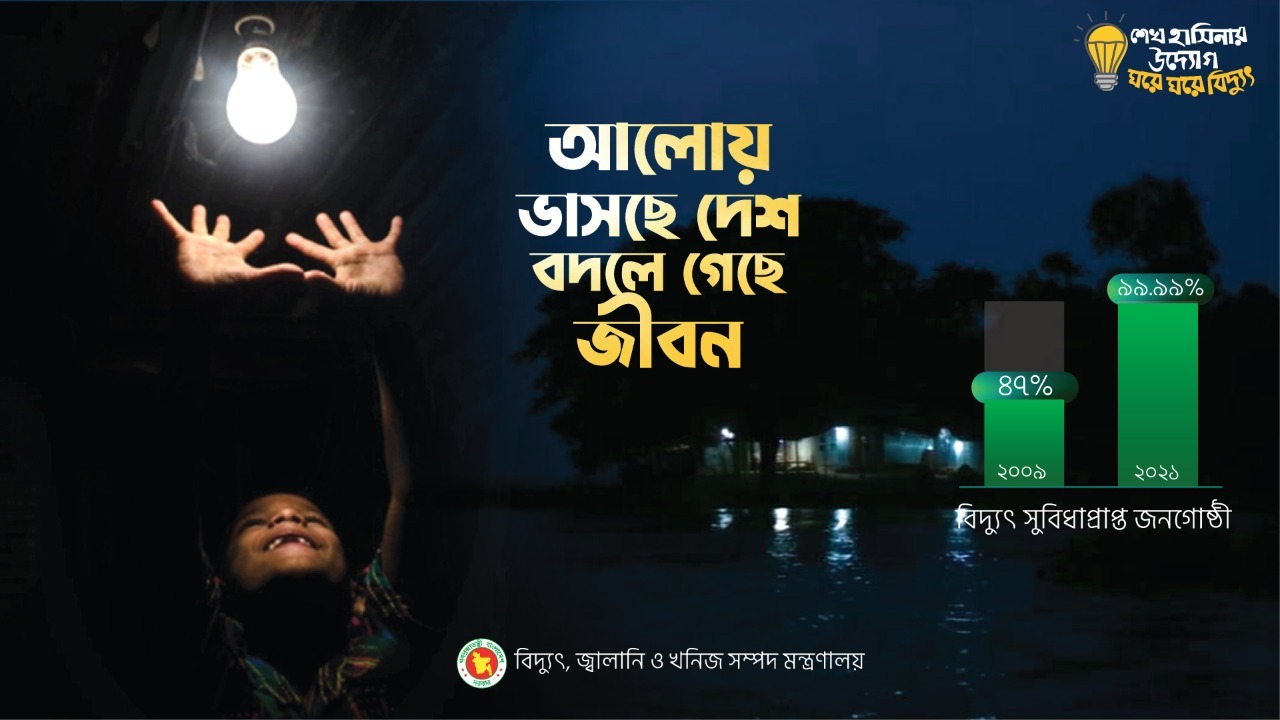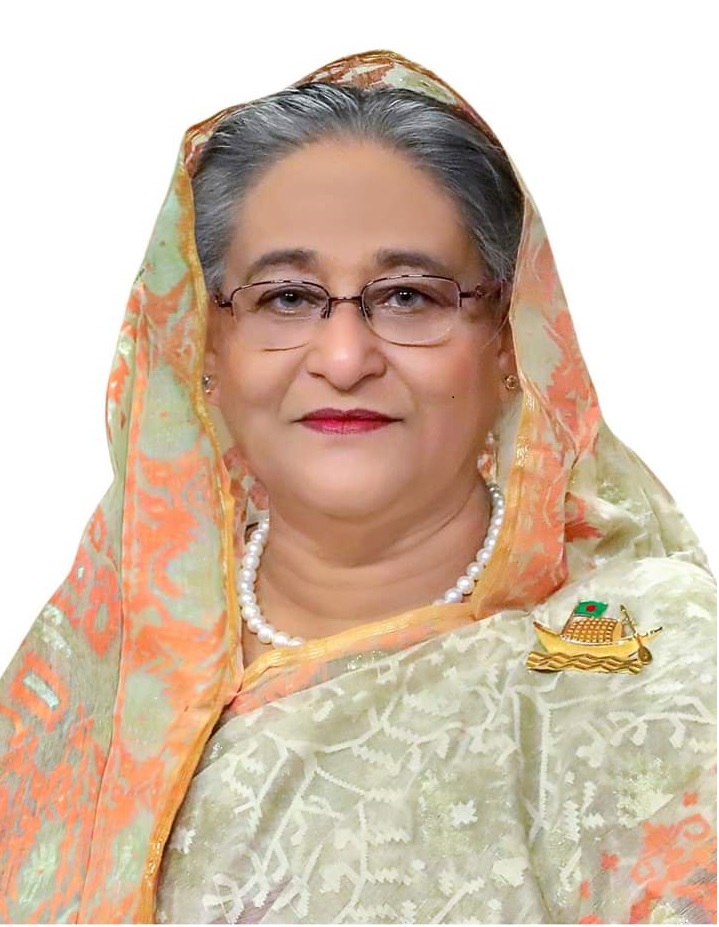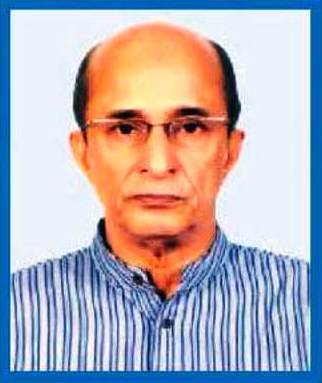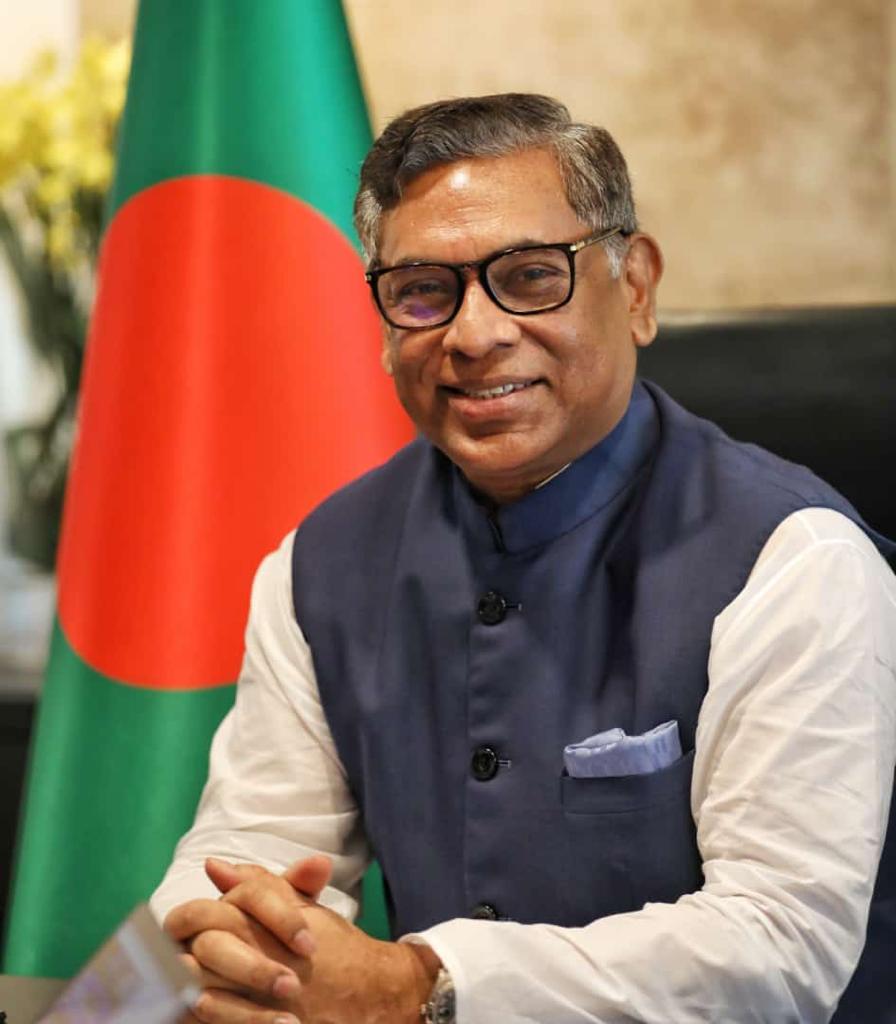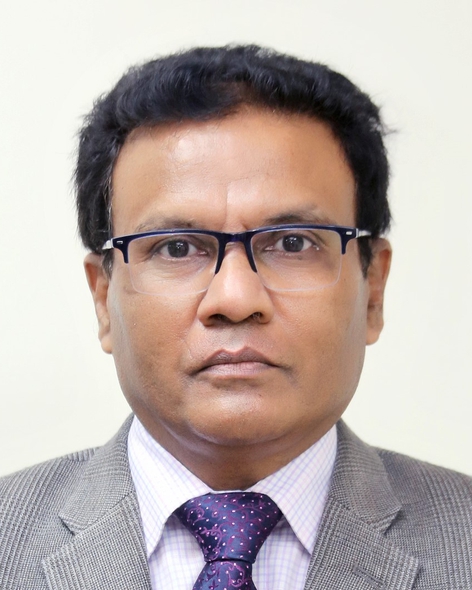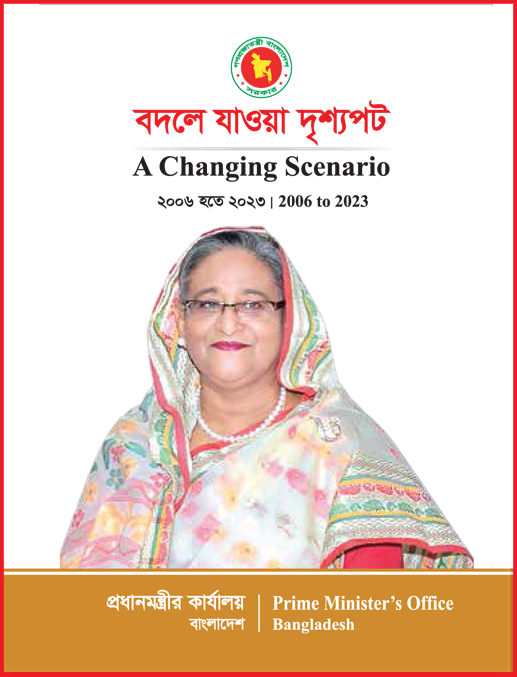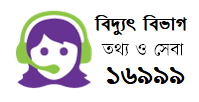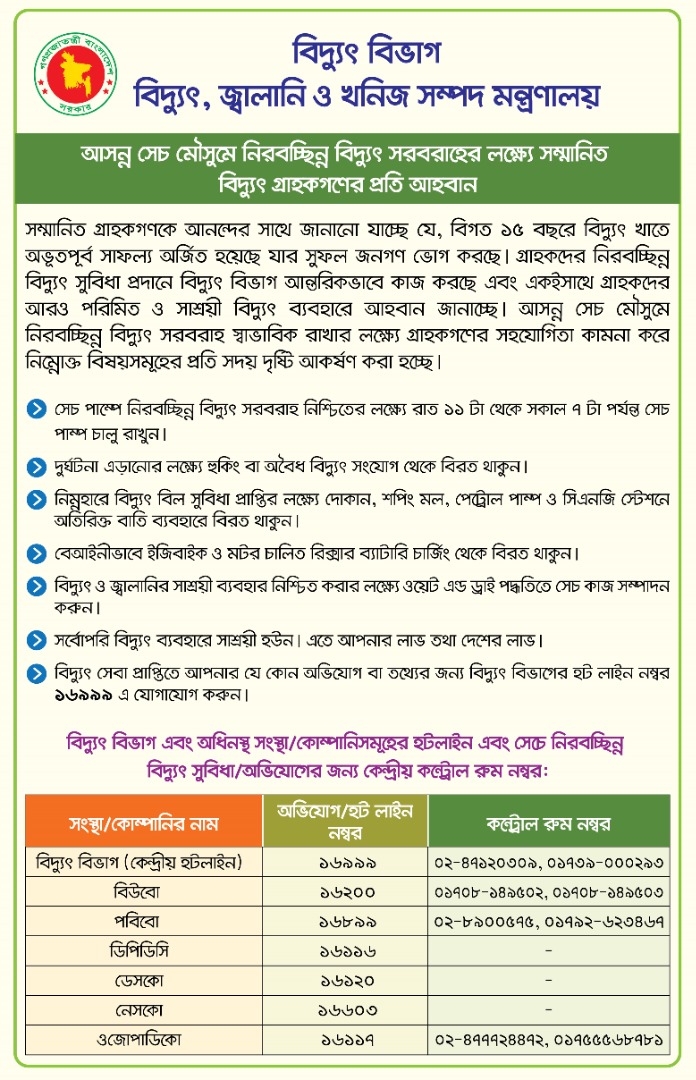আইসিটি ডেভেলপমেন্ট
Development of ICT is closely associated with the E-Governance issue of the government. E-Governance is the application of Information and Communication Technology (ICT) for delivering government services, exchange of information communication transactions, integration of various stand-alone systems and services between Government-to-Citizens (G2C), Government-to-Business(G2B),Government-to-Government( G2G) as well as back office processes and interactions within the entire government frame work .
With the advent of ‘Digital Bangladesh’ as a prime focus of the government, e-Government got a renewed vigor with the highest priority of the government. Hon’ble Prime Minister always emphasized on-‘bringing government services to the 'citizen's doorsteps'. This is the main essence of designing ICT development in power sector.
Keeping in view of the above, Power Division has taken number of initiatives in power sector, using ICT. The main objectives of ICT development in power sector are-
A. Improvement of service delivery system;
B. Institutional capacity development;
C. Establishment of good governance system;
A. IMPROVEMENT OF SERVICE DELIVERY SYSTEM
The issues which are directly related to the electricity consumers have been selected to improve their delivery system through ICT. The followings are the services that have been delivered through the use of ICT:
1. Bill Payment through Mobile Phone: The payment of bill was a hassle in a few years back. People had to queued to the Banks and had to spoil their valuable hours. Again, because of manual system and lack of proper coordination between the electricity utilities and the banks , it may so happened that consumers had been asked to pay their bill even after their payment. To solve this problem the billing system has been computerized, and the banks are giving the access to the consumer’s database. So the data will be updated upon payment by the consumer to the bank . Besides, now the consumers can pay their bills through mobile phone. Most of the utilities have already introduced this system as of now.
2. Bill Payment through On-line: Internet is now being getting popular day by day. Considering this fact, DPDC and DESCO have created on-line bill payment facility for their customers. REB is providing this facility through Union Information Centres. Other utilities are in the process of its implementation.
3. Electricity Connection through On-line: All the utilities have created the facilities for on-line electrical connection system. In the first phase both the manual system and the digital system will run simultaneously. The manual system will be phased out gradually and the digital system will stand ultimately. In this system the applicant has to submit their application on-line and after that applicant will receive SMS . The applicant can track the status of his file on-line. The applicant will get demand note through on-line. DESCO and DPDC extended this facility throughout their areas. Other utilities provide this facility to limited area, which will be expanded gradually throughout the country.
4. Complain Management System: Every consumer demands for early response to his complain. But the offices of the utilities have no good complain management system to cater the need of the consumers. The utilities have to rely upon traditional manual system and having no supervising system to monitor the activities of the stuffs handling the complain. That’s why there is dissatisfaction among the consumers. Considering this issue, the ICT based complain management system has been designed to be introduced by the distribution utilities. In this system the complain will be received through ‘Call Centers’ and there would be back hand automation of the office to resolve the complain. The Call Centers will be outsourced and the time will be assigned for the nature of the complain and the time of resolving the complain. Complain may be made through land line telephone, mobile phone, on-line etc. The voice of the call will be recorded and there will be a system of monitoring the complaint process . A Unified Complain Management System for all the distribution utilities will be developed, and it is in procurement process now.
5. On-line Recruitment System: The recruitment is an important job for all public offices. In some recruitment of power sector, thousands of candidates applied for different posts. It is very difficult to verify the documents of the candidates and to select primarily for interview. Again, issuance of interview card for candidates in large scale is another cumbersome job and it may so happen, the card may reach to the candidate even after the date of interview. To overcome this situation Power Division has initiated to computerized the whole recruitment system. Software has been developed, where application will have to be submitted through on-line and sorting of documents, issuance of interview cards and other related jobs will be done through computerized system. This system is now operating as trial basis and hopefully be implemented in a regular way soon.
6. On-line Meter Reading & Picture of meters: Very often the complain comes from the consumers side that the meter readers are not attending the meter of the consumer and submitted a fictitious bill and that creates a mistrust over the genuinity of the electricity bill. To overcome the situation, Power Division is now developing a system, where the meter reader will be provided with a mobile phone having an internet connectivity. Through this mobile the meter reader would have access to the consumer’s database. Upon entering the consumer’s premises, the meter reader will access the database and put the present meter reading of the consumers, simultaneously he will take a photograph of the present reading of the meter, that will automatically be added to the database.
This double checking system of meter reading will resolve the genuinity of the reading. Besides, the latitudinal and altitudinal reference will be generated during the reading through the system, which will mitigate the problem whether the meter reader actually took the reading at the premises of the consumer or not. Furthermore, as the reading is directly added to the database, so there is no need of further data entry by the data entry operators and have little chance of mistake in the reading of the consumer’s meter.
Different utilities are piloting this project in their respective pilot areas, which will be eventually expanded all over the country after having its success.
B. INSTITUTIONAL CAPACITY DEVELOPMENT
1. e-Filing System: Power Division has already been implemented the e-Filing system to its office. In this system the file management system will be digitalized. In this system the files could be tracked swiftly and where the files are pending could be tracked easily, and that would improve the rate of disposal of files. The experience would be replicated to other utilities afterwards.
2. On-line Project Management System: TheProject Director’s offices of different ADP projects are located in different parts of the country. What happened during monthly reviewing these projects in the ministry level- the project office had to send report to its controlling offices and that office consolidate the report and sent it to its HQ .HQ office consolidate all these reports and submitted to the Ministry. Ministry would then consolidate all the reports of all the utilities and placed these report before the monthly review meeting. This is really a cumbersome job and there is every possibilities of mistake in typing of figures. Now the projects are being monitored through on-line. The project offices give their entry of their own project, that are automatically been summarized. Hence, no paper works are needed during the monthly ADP review meeting and that has saved piles of paper works.
3. Setting up Video Conferencing System: For sharing information and monitoring different activities of the utilities, number of meetings had to convene in the ministry regularly. This consume much time for the top officials of the utilities. Some offices are located far away from the secretariat and because of traffic congestion, much of the valuable hours are lost to attend those meetings. To compensate this problem, video conferencing system has been set up with all the utilities. Now, the head of the utilities could attend the meeting sitting in front of the video system.
4. Introduction of PMS and FMS : To speed up the daily works of the offices, mostly all the utilities have introduced Personnel Management System and Financial Management System in their own offices. These systems are now functional in some of the offices of the utilities and some are in their implementation phases.
C. ESTABLISHMENT OF GOOD GOVERNANCE SYSTEM
1. Store Management System: The store management system of generation, transmission and distribution utilities in power sector is very important. The stores have to store materials having valuation of millions of taka (money) and have to transect costly materials. It is very difficult to keep inventory of all the materials in the traditional manual system, and there would have possibility of having corruption in transecting the materials. As each store has thousands of different materials, so it is very difficult to search any item manually. Computerized Store Management System overcomes this barrier and different power utilities are now being using this computerized software in their respective stores. Some stores are now fully computerized and some are in the process.
2. Introduction of AMR Metering System: As a sole buyer of electricity Power Development Board (BPDB) has to sell their electricity to different distribution utilities through transmission utility. Introduction of automated meter reading system in each selling point eased the accounts and billing system of the utilities.
3. Pre-paid Metering System: Power Division has initiated the introduction of pre-paid metering system to improve the billing and collection system of the electricity consumed by the consumers. Consumers have a general complain that their meters are not properly recorded in preparing their monthly bills. It is very difficult to supervise the activities of the meter readers, as each NOC has to take care of 30-40 thousands of consumers. Pre-paid metering system would resolve the problem and would give comfort to the consumers. It also help to recover the bill in-advance and have no possibility of dues of the bill. The meter could be controlled remotely and would have the facility of calculating peak and off peak hour consumption. In the first phase 35 thousand unified pre-paid meter will be installed and 2 million meters will be installed all over the country in phases.
4. Introduction of e-Tendering System: Procurement is the most important and delicate function of all government offices. Many complains are being heard on the process of procurement and bidders are often obstructed at the time of dropping tenders. So it is the good area to address this problem through introduction of e-Tendering system. CPTU is working on to implement this e-Tendering process. In the first phase Rural Electrification Board was the one among other four government entities. Other utilities like BPDB,DPDC,DESCO are in the pipe-line for the implementation of e-Tendering in their respective organization. Introduction of e-tendering will make the procurement process transparent and will immune the corrupt practices.
OTHER ICT ACTIVITIES:
Besides these above programs, different utilities are using different ICT based programs. Some utilities are working on implementing ERP(Enterprise Resource Planning),where all the modules will be integrated and the utility will be fully automated. APSCL ,at present , is in the process of its implementation. EGCB is also in this process, other utilities will also implement ERP in their respective organization in phases.
It may be noted that to increase the performance of all the utilities, Power Division has launched KPI (Key Performance Indicator) program from 2012 as a tool of Performance Appraisal System for the utilities. Different indicators have been set to monitor the performance of the utilities. DPDC has developed a computer based program, where the data for the indicators would automatically be generated from other module of the system. Say, computerized billing system would provide data for measuring the system loss of the utility. This will assist the top management to monitor the progress of the indicators regularly and to intervene for corrective measures very swiftly.

.jpg)

.jpg)
.jpg)
.jpg)
.jpg)
